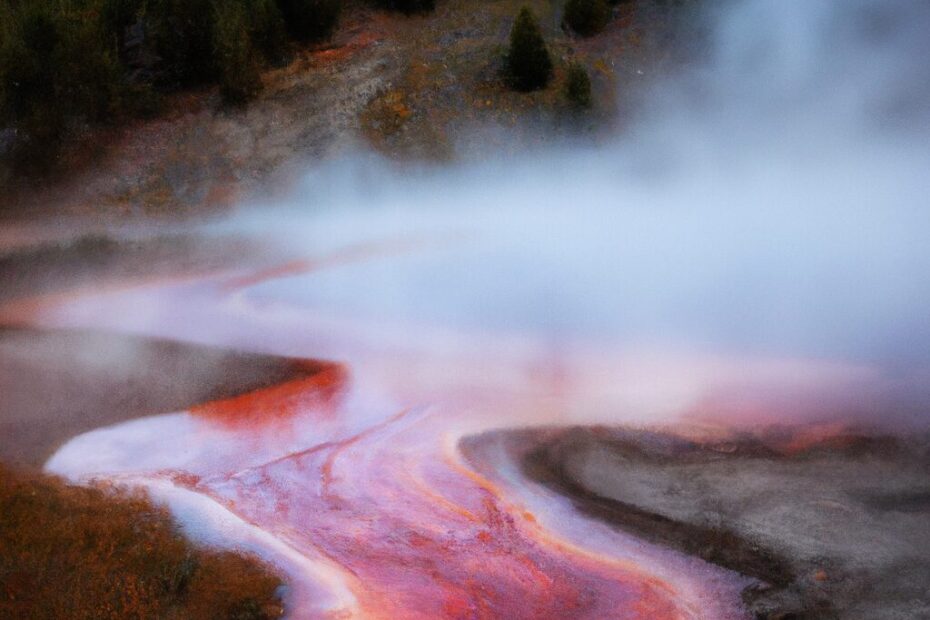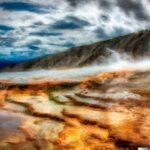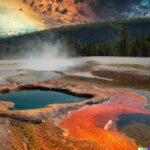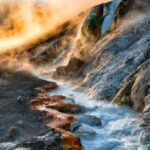Yellowstone National Park is famous for its stunning geysers, known for their unpredictable eruptions and breathtaking displays. But what causes these geysers to vary in temperature, and how are these variations measured?
In this article, we’ll explore the definition of geysers and what makes Yellowstone’s geysers unique. We’ll also delve into the role of water temperature, pressure, and minerals in causing temperature variations. We’ll discuss the effects of temperature variations on geyser behavior and how these variations can be predicted. Join us as we uncover the fascinating world of Yellowstone geysers.
What Are Yellowstone Geysers?
Yellowstone geysers are a captivating display of thermal features fueled by the volcanic activity within the iconic Yellowstone National Park.
These unique geological formations are a testament to the powerful forces that have shaped Yellowstone over millions of years. The park’s geysers, such as the famous Old Faithful, are notable for their regular eruptions, drawing visitors from around the world to witness nature’s spectacular performance.
The thermal features create a mesmerizing landscape, showcasing the intricate relationship between the earth’s internal processes and the natural beauty of the national park. Volcanic activity has played a pivotal role in sculpting the diverse terrain and contributing to the rich biodiversity that thrives within Yellowstone.
What Is The Definition Of A Geyser?
A geyser, particularly in the context of Yellowstone, is a hydrothermal feature known for periodic eruptions, driven by the release of thermal energy from the underlying hydrothermal system.
This natural phenomena is a result of the intricate relationship between water and heat within the Earth’s crust. The underground thermal energy heats the water that collects in underground reservoirs, creating immense pressure.
When the pressure exceeds the strength of the overlying rock, the superheated water and steam burst through the surface, resulting in a spectacular geyser eruption. The combination of geological activity and thermal energy creates a captivating display of Earth’s power and natural wonder.
What Makes Yellowstone Geysers Unique?
The uniqueness of Yellowstone geysers lies in their association with intense geothermal activity, driven by complex geological processes and influenced by various environmental factors within the park.
The remarkable natural features in Yellowstone showcase the powerful connection between the Earth’s internal heat and surface phenomena. These geysers are a result of water seeping deep into the ground, being heated by the magma beneath the Earth’s crust, and then erupting in spectacular fashion due to pressure build-up.
The geological processes over thousands of years have shaped the hydrothermal features, creating a mesmerizing display of nature’s forces. Factors such as temperature, precipitation, and altitude contribute to the diversity and behavior of these geysers, making each one a marvel to behold.
What Causes Temperature Variations In Yellowstone Geysers?
The temperature variations in Yellowstone geysers are primarily attributed to the heat source originating from the geyser basin, leading to dynamic fluctuations in the thermal conditions.
This heat source, fueled by the underlying volcanic activity, plays a pivotal role in shaping the unique thermal environment of the geyser basin.
As the subterranean heat interacts with the water table, it triggers a complex interplay of boiling, evaporation, and pressure, resulting in the spectacular geyser eruptions and the diverse thermal features that define Yellowstone’s geothermal landscape. The intricate balance of these factors contributes to the perpetual oscillation of temperatures, creating an environment teeming with geologic activity and natural wonder.
What Is The Role Of Water Temperature?
Water temperature plays a crucial role in governing the fluid dynamics and thermal behavior within Yellowstone geysers. Advanced temperature sensors are used to monitor and understand the hydrology and thermal dynamics of the system.
Maintaining an optimal water temperature is essential for regulating the rate of water flow. It directly impacts the fluid’s density and viscosity.
These temperature sensors provide real-time data on the thermal variations. This aids in predicting geyser eruptive behaviors and contributes to the overall comprehension of hydrological processes.
The integration of temperature measurements enables scientists to analyze the intricate relationship between thermal dynamics and water movement. This offers valuable insights into the geothermal ecosystem of Yellowstone.
What Is The Role Of Pressure?
Pressure serves as a critical factor influencing the geothermal gradient and is meticulously assessed through geophysical measurements to comprehend its impact on the thermal variations observed in Yellowstone geysers.
The relationship between pressure and the geothermal gradient is a complex interplay that often requires advanced geophysical measurements to accurately quantify. Understanding this correlation is crucial for predicting the behavior of geysers and other geothermal features in Yellowstone.
By analyzing the pressure variations at different depths, researchers can gain valuable insights into the thermal dynamics of the subsurface, shedding light on the intricate processes that shape the geothermal activity in the region.
What Is The Role Of Minerals?
Minerals play a pivotal role in influencing the chemical composition of thermal features. This has prompted extensive geothermal research to understand the geochemistry associated with the minerals present in the Yellowstone geysers.
The presence of minerals in geysers not only impacts their color and appearance, but also plays a significant role in shaping their distinct geochemical characteristics. This is due to the interaction between water, gases, and these minerals, resulting in the unique chemical signatures observed in geothermal features. Therefore, understanding the role of minerals is crucial in deciphering the complex geochemical dynamics within Yellowstone’s hydrothermal systems.
Geochemistry research is dedicated to unraveling these intricate relationships and their implications for the broader contexts of geothermal energy and the environment. By studying these processes, we can gain valuable insights into the functioning of geysers and their potential uses in various industries.
How Are Temperature Variations Measured In Yellowstone Geysers?
The measurement of temperature variations in Yellowstone geysers is facilitated through advanced techniques such as temperature sensors, thermal imaging, and comprehensive geothermal monitoring systems.
Temperature sensors are strategically positioned to continuously monitor and record temperature changes over time, offering valuable data for analysis. Thermal imaging allows for visualizing temperature variations across the geothermal areas, providing insights into the distribution and intensity of heat sources.
Geothermal monitoring systems further complement these techniques by offering real-time data on subsurface temperatures and fluid movements, enhancing the overall understanding of the geysers’ thermal dynamics.
What Tools Are Used To Measure Temperature?
Various tools, including geophysical measurements and advanced sensors, are utilized to capture temperature fluctuations, supporting the ongoing geothermal exploration efforts within the Yellowstone geyser basins.
Geophysical measurements play a crucial role in providing valuable data for understanding the complex geothermal systems in the region. These measurements enable scientists to analyze subsurface temperature gradients and identify potential areas for geothermal energy extraction.
By continuously monitoring temperature variations, researchers can gain insight into the behavior of Yellowstone’s geothermal features and make informed decisions regarding sustainable energy utilization. This comprehensive approach underscores the significance of integrating geophysical measurements into geothermal exploration projects, fostering a deeper understanding of this dynamic natural phenomenon.
What Factors Affect The Accuracy Of Temperature Measurements?
Several factors, including seismic activity and distinct thermal patterns, contribute to the complexity of temperature measurements. This necessitates comprehensive geothermal knowledge to ensure accurate and reliable data collection within Yellowstone geysers.
This intricate interplay of geological and thermal dynamics underscores the need for advanced monitoring techniques to detect subtle changes. The unique geological features of Yellowstone, coupled with its seismic activity, create an ever-evolving environment. Therefore, it is crucial to implement cutting-edge technologies and research methodologies. Understanding the thermal patterns within these geysers is imperative to gauge the health of the geothermal systems and detect any anomalies that may impact temperature measurements.
What Are The Effects Of Temperature Variations On Geysers?
Temperature variations exert significant effects on geyser eruptions, influencing the dynamics of the geothermal reservoir and shaping the observable heat variations within the Yellowstone geyser basins.
Temperature fluctuations are a key factor in the behavior of geysers at Yellowstone. Higher temperatures can result in more frequent and intense eruptions, while cooler temperatures may lead to a decrease in geyser activity. The geothermal reservoir beneath the surface is closely connected to these temperature changes, impacting the pressure and volume of water and steam within the geyser conduits. As a result, these shifts in heat not only affect the visual display of geyser eruptions, but also reveal the complex nature of Yellowstone’s geothermal activity.
How Does Temperature Affect Geyser Eruptions?
The temperature dynamics directly influence the formation of boiling water and are intricately linked to the thermal physics governing the behavior of geysers, particularly within the expansive geothermal fields of Yellowstone.
This correlation highlights the vital role of thermal physics in the natural spectacle of geyser eruptions within Yellowstone.
Understanding the intricate balance of temperature fluctuations and water movements is essential to comprehending the dynamic processes that unfold in these geothermal areas.
The interplay between heat transfer, water pressure, and geological formations underground contributes to the mesmerizing displays of boiling water shooting into the air at Yellowstone’s iconic geysers.
What Are The Implications Of Temperature Variations On Geyser Behavior?
The implications of temperature variations manifest in the form of steam emissions and are integral to understanding the behavioral patterns exhibited by the geothermal geysers within the expansive Yellowstone geothermal area.
Temperature variations are a key factor in the behavior of geysers, impacting their eruption frequency, intensity, and duration. The release of steam is a visual cue of the underlying geothermal activity, offering clues about the underground reservoirs and pressure build-up that leads to impressive geyser eruptions.
The geothermal area of Yellowstone provides a fascinating glimpse into the complex relationship between temperature, steam, and the breathtaking displays of natural geothermal phenomena.
How Can Temperature Variations In Yellowstone Geysers Be Predicted?
The prediction of temperature variations in Yellowstone geysers is intricately linked to the assessment of geothermal potential, showcasing the application of advanced geothermal technology and sustainable production methods within the geothermal fields of the park.
By integrating sophisticated exploration techniques, such as seismic imaging and geochemical surveys, scientists can analyze the subsurface heat distribution and identify reservoirs with substantial geothermal potential. This facilitates the strategic placement of geothermal wells and enhances the efficiency of energy extraction.
The utilization of advanced geothermal technology, such as binary cycle power plants and enhanced geothermal systems, maximizes energy production while minimizing environmental impact, contributing to the sustainable utilization of Yellowstone’s geothermal resources.
What Methods Are Used To Forecast Geyser Eruptions?
Forecasting geyser eruptions involves assessing the dynamics of the geothermal reservoir and integrating cutting-edge geothermal advancements and strategic initiatives for accurate predictive analyses within the Yellowstone geyser basins.
The methodologies employed for forecasting geyser eruptions are multifaceted, encompassing a range of techniques such as remote sensing, ground deformation monitoring, and seismic activity analysis.
Understanding the behavior of the geothermal reservoir is vital, and this involves studying the heat and fluid dynamics beneath the Yellowstone geyser basins. Integration of state-of-the-art geothermal advancements and strategic initiatives enables precise predictive analyses, considering factors like temperature variations, pressure changes, and chemical composition of the geothermal fluids.
How Accurate Are These Predictions?
The precision of predictions regarding geyser eruptions is underpinned by comprehensive insights into the geological formations, a profound understanding of geothermal knowledge, and the outcomes of rigorous geothermal studies conducted within the Yellowstone geothermal environment.
Accurate predictions of geyser eruptions in Yellowstone require a deep understanding of geological formations, extensive geothermal knowledge, and in-depth findings from studies within the geothermal environment. These factors are interconnected and crucial for accurate predictions, highlighting the need for a comprehensive understanding of the surrounding geological and geothermal dynamics.
Frequently Asked Questions
What causes the temperature variations in Yellowstone geysers?
The temperature variations in Yellowstone geysers are caused by a combination of factors including the type of geyser, the amount of water and steam present, and the location within the geyser basin.
How do scientists measure the temperature variations in Yellowstone geysers?
Scientists use thermal imaging and temperature probes to measure the temperature variations in Yellowstone geysers. They also collect data from nearby monitoring stations to track changes over time.
Are there any patterns or trends in the temperature variations of Yellowstone geysers?
Yes, scientists have observed that the temperature variations in Yellowstone geysers follow a cyclical pattern, with periods of higher and lower temperatures. They have also noted an overall increase in geyser temperatures over the past few decades.
How do temperature variations impact the eruption of Yellowstone geysers?
Temperature variations can greatly impact the eruption of Yellowstone geysers. Higher temperatures can result in more frequent and powerful eruptions, while lower temperatures may cause the geyser to become dormant or erupt less frequently.
Can temperature variations in Yellowstone geysers be predicted?
While scientists have a general understanding of the temperature variations in Yellowstone geysers, they are not able to accurately predict when and how much the temperature will fluctuate. This is due to the complex nature of geothermal systems and the many factors that can influence geyser temperatures.
Are there any safety concerns associated with temperature variations in Yellowstone geysers?
Yes, temperature variations in Yellowstone geysers can be dangerous for visitors if they are not aware of the potential hazards. Sudden increases in temperature can result in scalding hot water and steam being ejected from geysers, and visitors should always follow safety guidelines and stay within designated viewing areas.
Last Updated on January 25, 2024 by Jon Waraas – Originally Posted: January 25, 2024

I’m Jon Waraas, and I’ve been navigating the online world since 2006. By day, I’m the proud owner of some eCommerce gems, and by night, I’m the voice behind the adventures on Waraas.Com.
My heart, however, belongs to the wild beauty of Yellowstone National Park. I’ve got a collection of websites dedicated to sharing the wonders of this natural masterpiece. Oh, and did I mention? I’m currently building my own cabin inside the ghost town of Gilmore, Idaho – a cabin with tales to tell!
When I’m not immersed in the digital realm, you’ll find me lacing up my boots for a good hike or setting up camp under the star-studded sky.




